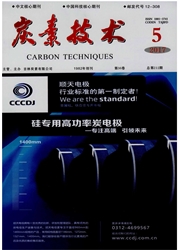

 中文摘要:
中文摘要:
以化学气相沉积(CVD)法生长的石墨烯作为基体,采用原位复合方法制备出三维石墨烯/碳纳米管纳米复合材料.使用扫描电子显微镜(SEM)和透射电子显微镜(TEM)对复合材料的微观形貌和结构进行表征,并运用循环伏安、交流阻抗等技术对纳米复合材料的超级电容性能进行研究.实验结果表明,石墨烯/碳纳米管纳米复合材料作为超级电容器电极材料,在1.5 mol/L Li2SO4体系中的最大比电容为289.8 F/g,经2000次循环后,其容量保持92%,表现出优异的比容量和循环稳定性.
 英文摘要:
英文摘要:
The development of more advanced and environmentally friendly energy storage devices is an urgent request to meet future societal and environmental needs. Supercapacitor is one of the most promising electrochemical energy storage devices owning to its long cycle life, high dynamic propagation, quickly response and low maintenance cost compared to the traditional batteries and capacitors. However, their energy density is far less batteries, which limits their application in energy storage. In order to break through the limitation, exploring novel electrode materials with both high energy densities and power densities is extremely urgent. At present, it is a hot topic to produce composite electrode materials with synergistic effect. Graphene, a one-atom-thick two dimensional single layer of sp2-bonded carbon, owning to its unique structural properties, has exhibited many advantages, such as extraordinarily high electrical and thermal conductivity, great mechanical strength and high surface area, making it a potential candidate for applications in energy storage field. Therefore, graphene based composite materials have been utilized in various practical applications, including energy storage and conversion, transparent conducting films, chemical sensors, and actuators, etc. Given the extraordinary properties of graphene, such as the low mass density, good compatibility, highly conductive, large specific surface area and excellent flexibility, it is considered as one of the most suitable substrate materials for preparing supercapacitor electrodes. In recent years, graphene composites as supercapacitor electrode material have been widely investigated. Here, threedimensional(3D) graphene/carbon nanotube(CNT) nanocomposites were prepared by in-situ compound method using as-synthesized graphene as matrix, which prepared by chemical vapor deposition(CVD). Firstly, graphene was prepared on Ni foam by CVD method using CH4 as carbon sources and H2/Ar as buffer gas at 850°C. Then a solution carbon source was obta
 同期刊论文项目
同期刊论文项目
 同项目期刊论文
同项目期刊论文
 期刊信息
期刊信息
